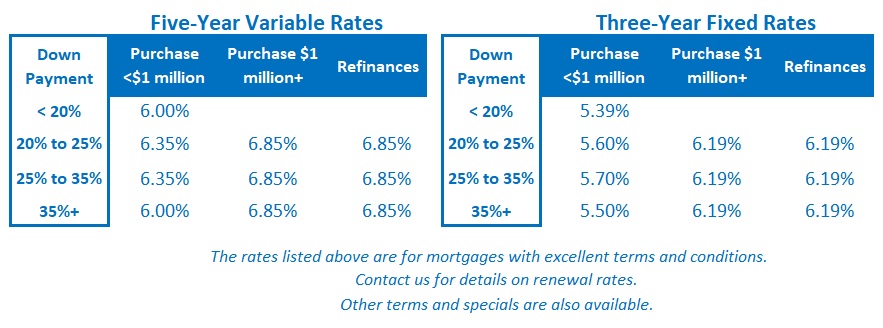The Canadian Economy Is Topping Out. Mortgage Rates Are Too.
December 4, 2023Canadian Mortgage Rates Are Set to Drop Again (Thanks to the US Fed)
December 18, 2023 The Bank of Canada (BoC) held its policy rate steady last Wednesday. Our mortgage lenders did the same with the prime rates our variable mortgage rates are priced on.
The Bank of Canada (BoC) held its policy rate steady last Wednesday. Our mortgage lenders did the same with the prime rates our variable mortgage rates are priced on.
The Bank’s accompanying policy statement offered a more balanced assessment of current conditions.
It acknowledged slowing economic momentum both at home and abroad, repeated the Bank’s concern about elevated inflation, and reiterated its “resolute” commitment to restoring price stability.
Here are my five key takeaways relating to the BoC’s most recent policy-rate decision:
- The BoC has finished with rate hikes.
The Bank didn’t formally announce that it has finished hiking its policy-rate this cycle. It didn’t want to trigger an over-reaction in the bond market that could undermine its efforts to further reduce demand (and cool inflation).
We saw that occur this past January.
At that time, the BoC announced that it was pausing its hikes. The bond market rallied hard (thanks, in part, to a “flight-to-safety” tied to the failure of several US banks). Government of Canada (GoC) bond yields plunged, along with the fixed mortgage rates that are based on them. That powerful stimulus reignited our housing markets and caused a spike in housing-related demand.
This time, the BoC stopped short of formally announcing another pause to avoid a similar reaction, but its assessment of current conditions left little doubt:
- … our economic growth has “stalled”
- … “higher interest rates are clearly restraining spending”
- … “business investment has been volatile but essentially flat”
- … “the labour market continues to ease”
- … “indicators for the fourth quarter suggest the economy is no longer in excess demand”
BoC Governor Macklem’s recent comment that “more downward pressure on inflation is [already] in the pipeline” is further proof that the Bank is satisfied that its monetary-policy tourniquet is already tight enough.
- The BoC’s first rate cut is probably not that far off.
The bond futures market has steadily shortened its anticipated timing of the BoC’s first rate cut, first from June to April and, more recently, from April to March.
There is typically a gap of about six months between the BoC’s last rate hike and its first rate cut. If past is prologue, the BoC’s first cut would be in January 2024 (since its last hike occurred in July 2023).
I don’t see the BoC cutting at its next meeting, on January 24, but it is now reasonable to expect a reduction as soon as its following meeting on March 6.
Our most recent economic data confirmed that our economy is slowing, and inflation is cooling more rapidly than either the BoC or the market consensus had forecast. As per my post last week, both of those trends portend a turning point in our interest-rate cycle.
Bond-market investors are pricing in about a 50% probability that the BoC will cut next March. I expect those odds to continue to increase as we head into the new year.
- We may see more rate cuts than expected in 2024.
The bond market is pricing in three 0.25% cuts by the BoC in 2024, but if our sharper-than-expected slowdown continues apace, I think we will see more.
I write that because, as the Bank has said many times, we haven’t yet felt the full force of the ten rate hikes that it has already made. The full impact of each hike usually takes between 18 and 24 months to fully manifest (because it takes time for higher borrowing costs to work their way into our economy). We won’t be 18 months past the BoC’s final hike until January 2025.
This time around, the impact of higher rates was further delayed by three factors that were unique to our current circumstances:
- Elevated pandemic savings allowed consumers to absorb higher pricing without adjusting their spending.
- Record levels of immigration inflated our overall GDP growth while diverting attention from our continuous decline in productivity.
- Fixed-payment variable-rate mortgages (where higher rates were reflected in extended mortgage amortizations instead of higher current payments) delayed the impact that higher rates had on the cash flows of Canadian variable-rate borrowers.
The combination of the above powerful influences made it harder for the BoC to cool inflation and forced it to tighten further than would normally be required.
That led to the sharpest series of BoC rate hikes in modern history despite our record levels of household and government debt, which will magnify the ultimate impact of all those rate increases.
For that reason, I think our economic momentum (and inflation) will now deteriorate more rapidly than expected, compelling the BoC to beat a hasty retreat to a more neutral policy rate (in the 3% range) to stave off a more severe slowdown.
- BoC Governor Macklem’s shift in emphasis is subtle (but noteworthy).
When BoC Governor Macklem speaks, we sometimes need to view his remarks through a filter.
At times like this, as I stated in section (1), he wants the Bank to appear somewhat more hawkish than it is to avoid the kind of market reaction that happened in January. But he also made a recent shift in emphasis that gives the Bank room to shorten its rate-cut timetable.
From last year through this summer, whenever he was asked about when rate cuts might materialize, Governor Macklem insisted that inflation would have to return “all the way back to the Bank’s 2% target” and that hitting the top end of the BoC’s acceptable inflation band of 1% to 3% would not be sufficient.
But then, in his testimony to the federal parliamentary finance committee on October 25, he changed his emphasis. He said that the Bank doesn’t need to hold rate cuts until inflation is all the way back to 2%. Instead it only needs “to wait until we’re clearly on a path to 2%.”
Being “on a path to 2%” is a subjective determination that allows the Bank much more flexibility on the timing of its rate cuts.
- Falling bond yields aren’t as potent this time.
If falling bond yields provide too much demand stimulus, as they did early this year, that could compel the BoC to keep its policy rate higher for longer.
The five-year GoC bond yield dropped by 0.75% between early February and early March, triggering rallies in our real-estate market and a surge in demand for other real-estate related products and services. That increased economic activity forced the BoC off the sidelines and led to two more 0.25% hikes in June and July.
This time around, bond yields have dropped by 0.80%. Thus far that decrease has not triggered a discernable uptick in real-estate related demand.
There are a couple of reasons for this.
First, our bond yields and mortgage rates are declining from much higher starting points. Even after their recent drops, they are still a little above where they peaked back in early February (so they still don’t look too enticing to borrowers).
Second, steadily rising interest rates in Q2 and Q3 slowed our economy and made it less responsive to stimulus this time.
While falling bond yields could still throw a wrench in the bond market’s views on where the BoC’s policy rate is headed, they would need to fall much faster and/or further than they have thus far. They would likely need to drop below the lows we witnessed in March to produce a similar impact.
Mortgage Selection Advice
If you’re in the market for a mortgage today, variable rates look increasingly appealing if you can tolerate variable-rate risk and are prepared to be patient. Bluntly put, I think variable rates are likely to produce the cheapest borrowing cost over the five years ahead (based on my view that rates have peaked for this interest-rate cycle).
If you want to guard against the risk that inflation will prove stickier than the above analysis indicates (because that is still a possibility), I think three-year fixed rates are the best option. The rate premiums for shorter one- and two-year fixed rates are prohibitively high, and I worry that five-year fixed rate terms will lock borrowers into today’s still relatively high rates for too long.
Bonus video link: In this wide-ranging interview with Strictly Money anchor Saijal Patel, we talk about mortgage rates, housing affordability, thoughts on the coming “mortgage cliff”, and finish with a few rapid-fire questions. The Bottom Line: Although GoC bond yields were range bound last week, lenders continued to drop their fixed rates in response to previous bond-yield declines.
The Bottom Line: Although GoC bond yields were range bound last week, lenders continued to drop their fixed rates in response to previous bond-yield declines.
Variable-rate discounts were unchanged, as were lender prime rates, following the BoC’s decision to hold its policy rate steady.
Better still, it now looks as though the Bank will start cutting its policy rate earlier in 2024 than previously expected. This will be welcome news to variable-rate borrowers who may have forgotten that their rates can go down as well as up.







